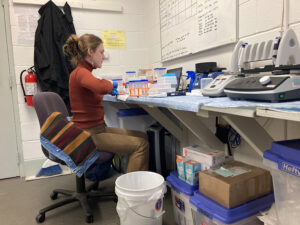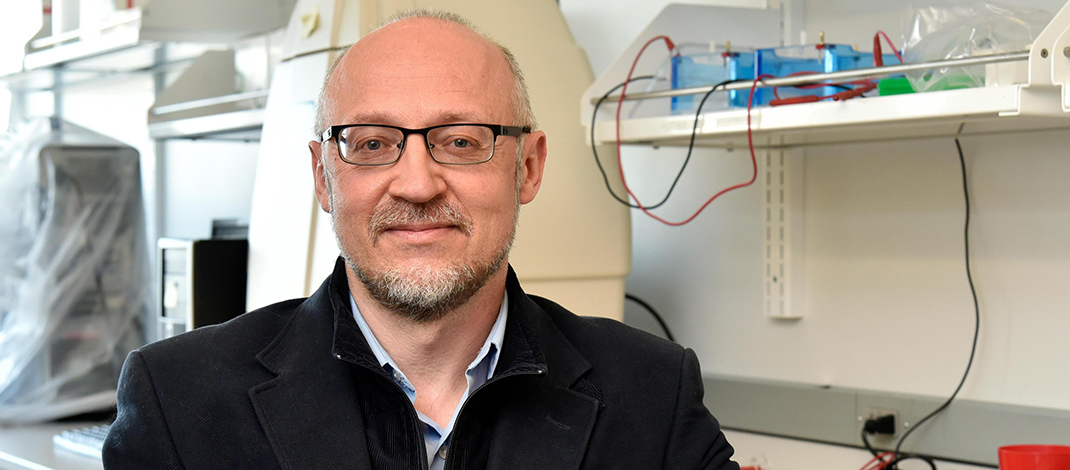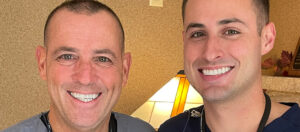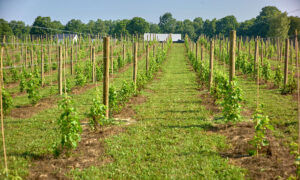Business started in 2022 in Oswego incubator now operating in the black
By Stefan Yablonski

From fish to rodents — and a whole lot more — Stress Bionalytics, LLC. has exploded.
Kestas Bendinskas, a distinguished service professor of SUNY Oswego’s chemistry faculty, set up shop at the Business Expansion Center in Oswego in the summer of 2022. He started with an impressive client list: University of Denver, a veterinarian from Long Island, Colorado State, a doctor from Puerto Rico, Harvard and others.
He recently got a contract with the Lincoln Park Zoo in Chicago.
His business was hired to analyze the stress levels of animals of the zoo, “A big contract,” he said.
He is also working with an organization to test the stress levels of the population in sections of Ukraine.
Last year, he got additional contracts — more than 200. That’s from a handful a year before. He was able to pay off all the equipment he bought to get his business started, as well as some other items. He put the price tag “in the range of $ 30,000.” In one year — all investments are covered, “we are not in red any longer,” he said.
“The Lincoln Park Zoo in Chicago — the oldest zoo in the country — contacted me. They found out about me from the Smithsonian Zoo. I was like, ‘how do they know about me?’ It’s a mystery. That remains a secret. I don’t know how it came to be.”
He said he was curious as to what samples they were going to send him. “They were raccoons and weasels and rats from Chicago city. They are assuming animals in the city are all under stress,” he explained. “Mammals and rodents — rodents are very different from the rest of the mammals, their stress amounts are different, actually. When we look at animal samples we always have to be careful that we analyze cortisol for most of them; but for birds and rodents we analyze corticosterone, it’s like a cousin of cortisol,” he added.
Gone fishing
That’s one unexpected project that came his way.
“Another very unexpected project comes from Lake Ontario — fish.
How and why would you want to measure stress in fish, right?” he said.
The bloater reintroduction project is conducted by USGS Great Lakes Science Center, Tunison Laboratory of Aquatic Science, Cortland. Bloater is a herring-like fish. They are releasing fish into the lake.
“In the last two years they have had pretty bad luck with the fish,” Bendinskas said. “They thought big fish ate the small fish. But last year, around 50% of the fish died — immediately!”
They assume it might have been caused by stress from being transported and they asked Bendinskas to check.
“We tried fish saliva and it didn’t work, we failed. Then they sent us blood samples and testing was successful,” he said. “Now we’re going to expand to probably 2,000 samples in which they will study the variety of conditions for transportation — different temperatures and other parameters — to make sure that all the fish when released survive.”
They can see how cortisol increases …stress one hour into the trip, two hours into the trip and so on. “Now they can see how they can change transportation conditions so stocking is twice as successful,” he added.
“Another interesting project that I want to share, that we are very proud to be a part of, comes from Duke University. They want to see how air-raid sirens are related to stress. As far as I understand, people in five cities in Ukraine will be assessed for physiological and psychological stress. The variables studied will include the number of air-raid sirens and actual bombings, among many,” he said. “We are very happy and proud to be a small part of this project; if there is anything we can do to help, we will.”
Victoria Bulson is the manager at the lab. They have three interns working “flexible hours,” Bendinskas said.
“Victoria was a student at Oswego. She applied to three med schools, got accepted to two,” he said. “But until then, I am really lucky to have her. She is very responsible. If you fail any of these steps you have to spend days recouping.”
Maximum concentration
There is no background music playing. Not a phone in sight.
“We need to focus on what we are doing. I started officially working in May [2023], but I was training a few months prior. So it’s probably about a year,” Bulson said. “I took bio chem. 1 and 2.”
“It is probably one of the most challenging college classes,” Bendinskas said.
The testing processes can take three or four days.
“You do the same thing over and over again. It’s kind of mindless — but then you get consistent with it and you are always careful, you don’t want to ruin someone’s sample and have to start all over again. It’s about being consistent so that you put out more consistent results,” she added. “Getting into a groove, doing the same thing all the time works in your favor. Being consistent, getting good, accurate results is important.”
If you’re thinking about something else, mistakes can happen, Bendinskas said.
“People spend months and sometimes years collecting those samples. We want to make sure we do things right. We can not afford to make a mistake,” he said. “We prepare twice as much sample as needed, just in case the analysis fails, we have the second half to review it. We have learned the pitfalls and now hopefully we avoid them and don’t make any mistakes. We are more busy than I would have expected. This past year and a half we processed more than 4,000 samples.”
Cortisol
Cortisol increases dramatically in concentration when one experiences short-term or chronic stress. The immediate response can be assessed by measuring in saliva, long-term in hair.
Cortisol, the primary stress hormone, increases sugars (glucose) in the bloodstream, enhances your brain’s use of glucose and increases the availability of substances that repair tissues. Cortisol also curbs functions that would be nonessential or harmful in a fight-or-flight situation.
It is nature’s “built-in alarm system” — your body’s main stress hormone; working with certain parts of your brain to control your mood, motivation and fear.
Your adrenal glands — triangle-shaped organs at the top of your kidneys — make cortisol.
It is extracted from milled hair and measured using a technique called ELISA.
“The extraction procedure takes three days because we have to extract it twice — overnight. But we can process up to 40 samples per day and also stagger samples; our current capacity is about 6,000 samples annually (with one manager and three interns),” Bendinskas explained.
The data is used by medical, sport and psychology specialists who often prefer getting a physiological measure of stress, instead of an opinion about one’s stress.




